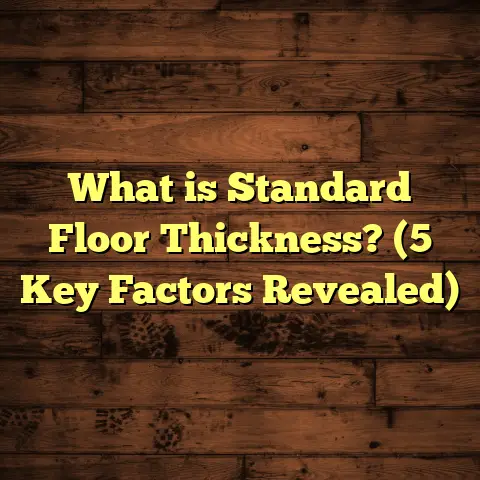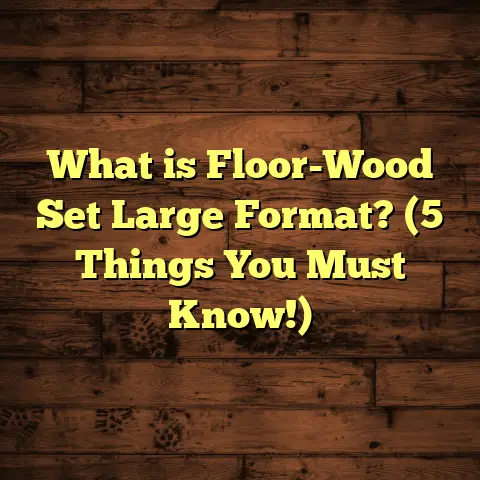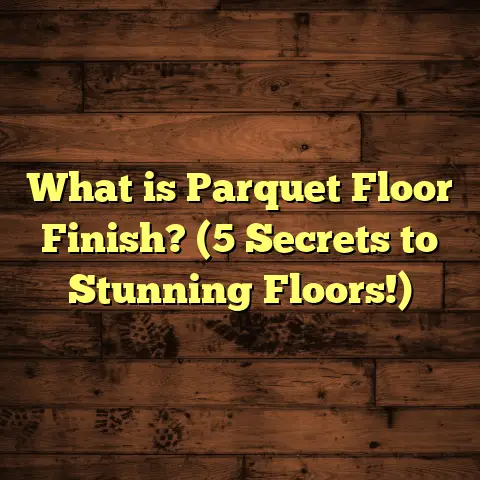What is T and B in a Floor Plan? (5 Key Design Insights)
When I first got into flooring, I was surprised by how much the layout of a house could affect the quality of life—not just visually but physically. You might think flooring is just about picking a nice color or a trendy wood grain. But I learned early on that things like allergies can be heavily influenced by how your floor plan is designed. And here’s where something as simple as T and B in a floor plan comes into play.
You might be scratching your head right now, wondering what exactly T and B stand for, and why they matter to you if you’re planning a flooring project or even just trying to understand your home better. Let’s chat about this because it actually affects everything from installation accuracy to your daily breathing comfort.
What is T and B in a Floor Plan?
Alright, let’s start with the basics. T and B in a floor plan stand for “Top” and “Bottom.” These letters help show orientation on a drawing of a space. Imagine looking down on your house from above, kind of like a bird’s eye view. The “Top” refers to the upper side of the drawing, and the “Bottom” refers to the lower side.
But these aren’t just directions like north or south—T and B help clarify which side of an element in the floor plan we’re talking about.
For example:
- When you see a door on a floor plan, T might indicate which side of the door frame is considered the top edge.
- For walls or windows, T and B mark which edge or face you’re referring to.
This is super important when you’re installing flooring because it affects how materials fit together and how they interact with walls, doors, and other features.
My Early Experience with T and B Confusion
I remember my first big job fresh out of apprenticeship. The architect handed me a floor plan filled with T and B markings but didn’t explain them. My team and I assumed “Top” meant north and “Bottom” meant south. That was wrong.
We started installing hardwood planks thinking the T side was on one wall when it was actually on the opposite. By the time we caught it, several boards had been cut incorrectly and installed backwards relative to door swings. Fixing that took extra days and cost extra money—not fun at all.
From then on, I made it a point to clarify these markings upfront with clients and contractors. It saves headaches down the line.
Why Are T and B Important Beyond Just Direction?
You might think knowing “top” and “bottom” is just a detail for architects or builders. But it actually impacts many parts of your flooring project:
1. Precise Flooring Layout
When cutting hardwood or vinyl planks, installers need to know exactly where to place each piece so it fits perfectly against walls or thresholds. The T/B markers tell us which edge of the room or doorway we are working with.
Without this info, you risk:
- Wasting material by cutting wrong lengths.
- Creating awkward gaps.
- Having to redo sections.
2. Door Swing and Flooring Transitions
Ever noticed how doors open in or out? That matters when you install flooring because of thresholds—those strips where two different floors meet (like from tile to carpet).
T and B markers help us:
- Determine which side of the door frame to install these strips.
- Align flooring patterns smoothly.
- Avoid tripping hazards by choosing the right thresholds.
3. Airflow Patterns Affecting Allergies
Here’s where things get interesting if you suffer from allergies like I do.
I learned from a client who struggled with dust allergies that their home’s airflow was poor in certain rooms. After examining their floor plan, we noticed that door swings and room orientation (represented by T and B) restricted natural air movement.
Because airflow helps move dust and allergens out of rooms, understanding how doors open (which direction T and B indicate) can help optimize air circulation. Proper airflow means:
- Less dust buildup.
- Reduced allergens.
- Healthier living environment.
4. Flooring Patterns and Aesthetics
If you want your floorboards arranged in specific patterns (like herringbone or diagonal), T and B markers guide the alignment so patterns flow consistently through adjoining rooms.
I once worked on a project where the client wanted a diagonal plank layout flowing from the living room into the dining room seamlessly. Using T/B markers, we oriented the planks correctly across thresholds, creating a smooth visual transition that impressed everyone.
5. Waste Reduction and Budgeting
Using software tools like FloorTally—which incorporates T and B info—you get smarter estimates on how much flooring material you’ll need.
This reduces waste because:
- The software can calculate cuts based on exact room orientation.
- It includes waste factors for irregular shapes.
- You avoid ordering too much or too little.
It saves money and helps keep your project on budget.
Digging Deeper: How Does T and B Affect Flooring Installation Step-by-Step?
Let me walk you through a typical flooring installation process and show you where T and B come into play.
Step 1: Reviewing the Floor Plan
Before any materials arrive, I sit down with my team and go over the floor plan carefully.
We identify:
- Which walls are marked as Top (T) and Bottom (B).
- Door swings relative to these markers.
- Window placements.
This step helps us visualize how planks will run through each room.
Step 2: Planning Material Cuts
Knowing orientation lets us plan cuts efficiently. For example:
- If the bottom edge of a room has uneven walls or doorways, we plan to cut planks precisely for that side.
- We consider how planks will meet thresholds at doors marked with T/B.
Mistakes here lead to wasted boards or gaps later on.
Step 3: Aligning Flooring Patterns
We use T/B markings to align patterns so they flow naturally from room to room.
If planks are laid perpendicular in one room but don’t match direction at the adjoining doorway, it looks disjointed.
One project I handled involved matching oak hardwood from a hallway into bedrooms seamlessly—T/B made that alignment clear.
Step 4: Installing Transition Pieces
At doorways or where flooring types change (say hardwood to tile), transition strips go in.
T/B markers tell us:
- Which side gets the transition strip.
- How far it extends into each room.
Proper placement prevents tripping hazards while keeping aesthetics clean.
Step 5: Final Inspection
Once installed, we check alignment against our original floor plan’s T/B designations to ensure everything fits perfectly.
Real-Life Story: Allergy Relief Through Thoughtful Flooring Design
A couple of years ago, I worked with a family whose son had severe allergies. Carpet was out of the question for most rooms because it traps dust mites. The floor plan showed several bedrooms connected by small hallways with doors swinging inward.
The problem? The airflow was stagnant in these areas due to door positioning (which we clarified using their T/B floor plan).
We made these changes based on that understanding:
- Switched door swings on some rooms to improve air movement.
- Installed hardwood floors throughout instead of carpet.
- Added low-profile thresholds guided by T/B markings for smooth transitions.
After moving back in, they reported fewer allergy flare-ups and easier cleaning routines.
This case showed me how technical details like T/B can directly influence health outcomes inside homes.
Technical Insight: How Architects Use T and B in Floor Plans
Architects don’t just slap down letters randomly. There’s method behind it:
- Top (T) often corresponds with the main entry or primary facade.
- Bottom (B) usually marks secondary access points or less prominent sides.
This helps contractors orient themselves quickly on large projects with multiple floors or buildings.
Sometimes plans will also include L (Left) and R (Right) alongside T/B for full spatial orientation.
Understanding this language helps when coordinating between architects, installers, electricians, and plumbers.
How Modern Software Leverages T and B for Flooring Projects
Digital tools have transformed flooring projects dramatically. Programs like FloorTally use your floor plan data—including T/B—to automate calculations such as:
- Material quantity estimation.
- Waste factor analysis based on room shape.
- Cost estimation using local labor/material rates.
For example, if your floor plan shows that one wall (marked Top) has an irregular shape due to a bay window, FloorTally adjusts material needs accordingly instead of assuming a perfect rectangle.
I’ve used FloorTally on projects ranging from small apartments to luxury homes. It saves hours of manual calculation—and reduces errors.
What You Can Do When Reviewing Your Floor Plan
You don’t need architecture training to use T/B insights effectively. Here’s how you can start:
1. Ask Your Designer or Contractor About T/B Markings
When someone gives you a floor plan, ask them what those letters mean if it’s not clear.
2. Check Door Swings
Look at each doorway on your plan:
- Does it swing into or out of rooms?
- Which side is marked “Top”?
This affects where thresholds go and how flooring aligns at transitions.
3. Think About Your Cleaning Routine
Knowing which sides are Top/Bottom can help you place furniture so airflow isn’t blocked near vents or doors—reducing dust traps.
4. Use Online Tools That Support Floor Plan Inputs
Upload your plans into apps like FloorTally that understand these markings for better budgeting.
Flooring Choices Connected to T and B Orientation
I want to share some quick thoughts about popular flooring types connected to layout orientation:
| Flooring Type | Installation Tip Related to T & B | Allergy Consideration |
|---|---|---|
| Hardwood | Align planks along “Top” wall for flow | Easy to clean; doesn’t trap dust |
| Laminate | Use underlayment especially near bottom edges | Hypoallergenic surface |
| Vinyl Plank | Plan cuts where “Bottom” walls have doorways | Resistant to moisture/dust |
| Carpet | Avoid high traffic “Top” zones | Traps allergens; needs regular cleaning |
| Tile | Place tiles perpendicular to “Top” walls | Easy clean; cold underfoot |
Common Mistakes Related to Misunderstanding T and B
I’ve seen these slip-ups multiple times:
- Installing flooring backwards relative to door swings.
- Ordering wrong amount of material due to ignoring irregular shapes indicated by top/bottom sides.
- Misaligned patterns across connecting rooms.
Avoid these by double-checking plans before starting work or ordering materials.
How Allergies Connect Back to Flooring Layouts & Materials
Here’s some data from studies on indoor allergens that caught my attention.
- Homes with smooth flooring surfaces reduce dust mite populations by up to 60% compared to carpeted homes.
- Proper airflow reduces airborne allergens by an average of 30%.
- Door positioning (linked to T/B) influences airflow patterns significantly in small homes under 1500 sq ft.
So if your floor plan’s T/B markings help improve airflow via door swings or room orientation, it truly impacts health day-to-day.
How I Help Clients Understand This Stuff Without Overwhelming Them
Not everyone wants an architecture lesson when buying floors! When I talk to clients about T/B marks, I keep it simple:
- Explain it’s about which side of doors/walls we’re talking about.
- Show them on their own plans with colored markers.
- Relate it back to how it affects their flooring pattern or cleaning ease.
This personalized approach gets great feedback because clients appreciate knowing why things matter without jargon overload.
Final Reflection: Why Learning About T and B Will Make Your Project Smoother
If you take nothing else away today, remember this:
Understanding what T and B mean on your floor plan helps save money, reduces stress during installation, improves aesthetics, and can even impact your family’s health through better airflow and cleaning ease.
It’s one of those small details that makes a big difference in how your home feels and functions once construction is done.
If you’re tackling a remodeling project or building new, take a few minutes with your floor plan today. Look for those little letters—T and B—and ask your team what they mean for your floors. Trust me, that chat will pay off in spades later on!
If you want me to walk through your specific floor plan or help pick flooring tailored for allergy-friendly living spaces, just reach out anytime—I’ve got plenty more stories and tips waiting for you!
(End of article)





